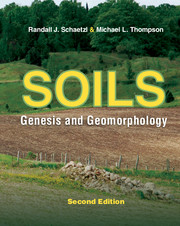14 - Soil Geomorphology and Hydrology
Published online by Cambridge University Press: 12 January 2024
Summary
Introduction to Soil Geomorphology
Geomorphology is the study of landforms and the evolution of the Earth's surface. Because soils are so strongly linked to the landforms upon which they develop, a discipline that dealt with those relationships eventually emerged: soil geomorphology. Popularized by Pete Birkeland in the 1970s and 1980s, soil geomorphology came into its own with the publication of a number of books by Birkeland and other scholars during this time, all devoted to the topic and helping to define the field (Mahaney 1978, Gerrard 1981, 1992, Richards et al. 1985, Daniels and Hammer 1992, Paton et al. 1995). In 1999, Birkeland had defined soil geomorphology as the study of soils and their use in evaluating landform evolution, age, and stability, surface processes, and past climates. Wysocki et al. (2000) more broadly defined it as the scientific study of the origin, distribution, and evolution of soils, landscapes, and surficial deposits, and the processes that create and alter them. McFadden and Knuepfer (1990) emphasized the linkages between pedogenic and other surficial processes, in their definition of the field. Perhaps the definition we like best was presented by John Gerrard in 1992: Soil geomorphology is an assessment of the genetic relationships between soils and landforms.
Yes, soils and landforms develop together. Many times, it just makes sense to study them together. Soil geomorphology is designed to examine and elucidate the nature of that genetic dance. But it is a two-way street. Soils are affected by landforms, and through their developmental accessions and features, they in turn influence geomorphic evolution. Most importantly, pedogenic processes are variously dependent and intertwined with slope processes, e.g., erosion and sedimentation. And on top of it all, the influence of landforms on the flow of water – across the soil surface and belowground – impacts soils markedly. This is the essence of soil geomorphology – putting all these interrelationships together.
Historical Background
Soil geomorphology was first studied in its own right by the U.S. National Cooperative Soil Survey (NCSS) program in the 1930s. At that time, interests had developed among geographers, geologists, and soil scientists on the relationships between soils and landforms (Effland and Effland 1992, Holliday 2006). Acknowledging the merit in this type of approach, the NCSS adopted soil geomorphology as a paradigm for studying soil landscapes.
- Type
- Chapter
- Information
- SoilsGenesis and Geomorphology, pp. 445 - 525Publisher: Cambridge University PressPrint publication year: 2015

